air condition RENAULT KANGOO 2013 X61 / 2.G Diesel DCM 1.2 Injection Workshop Manual
[x] Cancel search | Manufacturer: RENAULT, Model Year: 2013, Model line: KANGOO, Model: RENAULT KANGOO 2013 X61 / 2.GPages: 204, PDF Size: 0.99 MB
Page 3 of 204
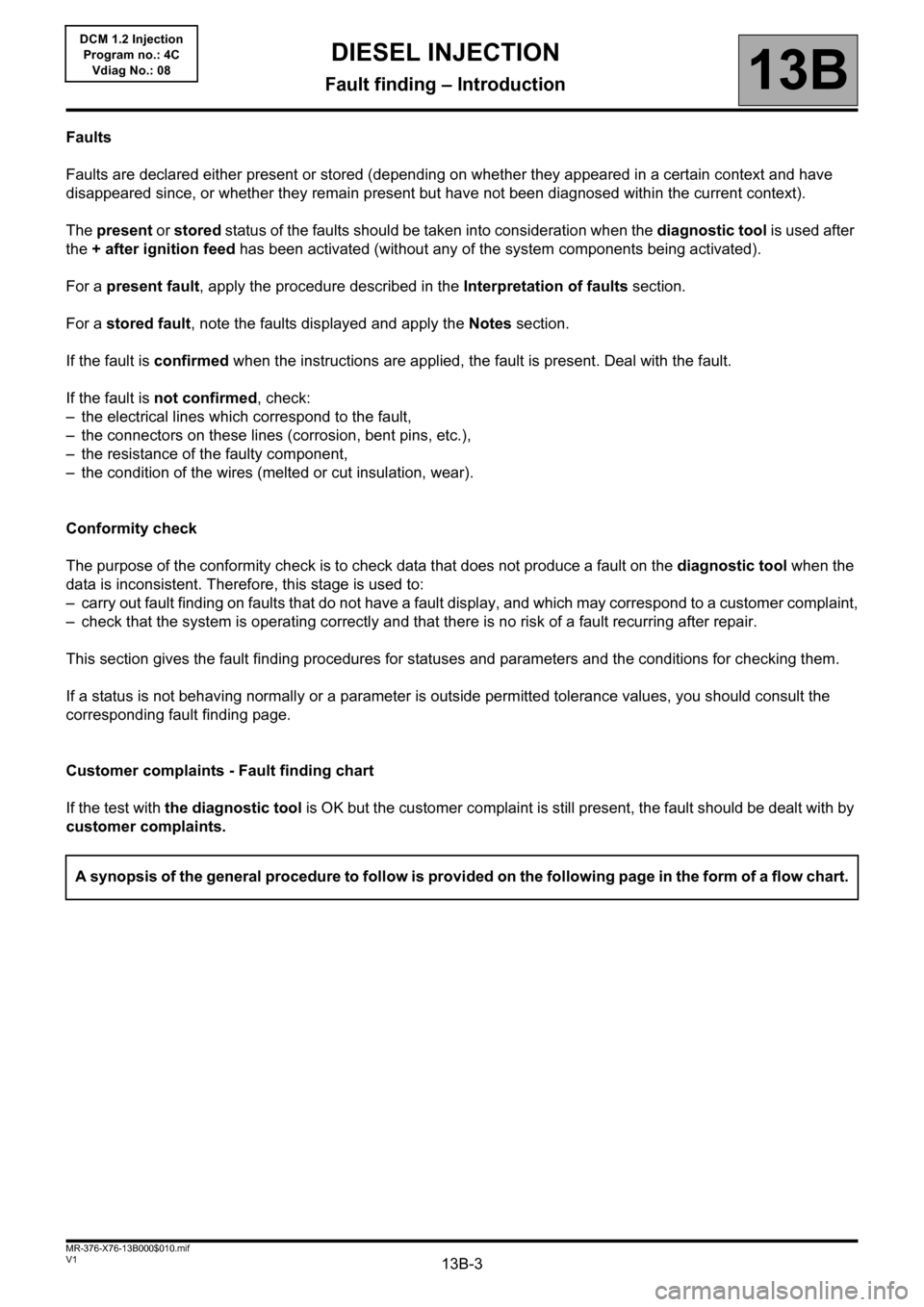
13B-3V1 MR-376-X76-13B000$010.mif
DIESEL INJECTION
Fault finding – Introduction13B
DCM 1.2 Injection
Program no.: 4C
Vdiag No.: 08
Faults
Faults are declared either present or stored (depending on whether they appeared in a certain context and have
disappeared since, or whether they remain present but have not been diagnosed within the current context).
The present or stored status of the faults should be taken into consideration when the diagnostic tool is used after
the + after ignition feed has been activated (without any of the system components being activated).
For a present fault, apply the procedure described in the Interpretation of faults section.
For a stored fault, note the faults displayed and apply the Notes section.
If the fault is confirmed when the instructions are applied, the fault is present. Deal with the fault.
If the fault is not confirmed, check:
– the electrical lines which correspond to the fault,
– the connectors on these lines (corrosion, bent pins, etc.),
– the resistance of the faulty component,
– the condition of the wires (melted or cut insulation, wear).
Conformity check
The purpose of the conformity check is to check data that does not produce a fault on the diagnostic tool when the
data is inconsistent. Therefore, this stage is used to:
– carry out fault finding on faults that do not have a fault display, and which may correspond to a customer complaint,
– check that the system is operating correctly and that there is no risk of a fault recurring after repair.
This section gives the fault finding procedures for statuses and parameters and the conditions for checking them.
If a status is not behaving normally or a parameter is outside permitted tolerance values, you should consult the
corresponding fault finding page.
Customer complaints - Fault finding chart
If the test with the diagnostic tool is OK but the customer complaint is still present, the fault should be dealt with by
customer complaints.
A synopsis of the general procedure to follow is provided on the following page in the form of a flow chart.
Page 4 of 204
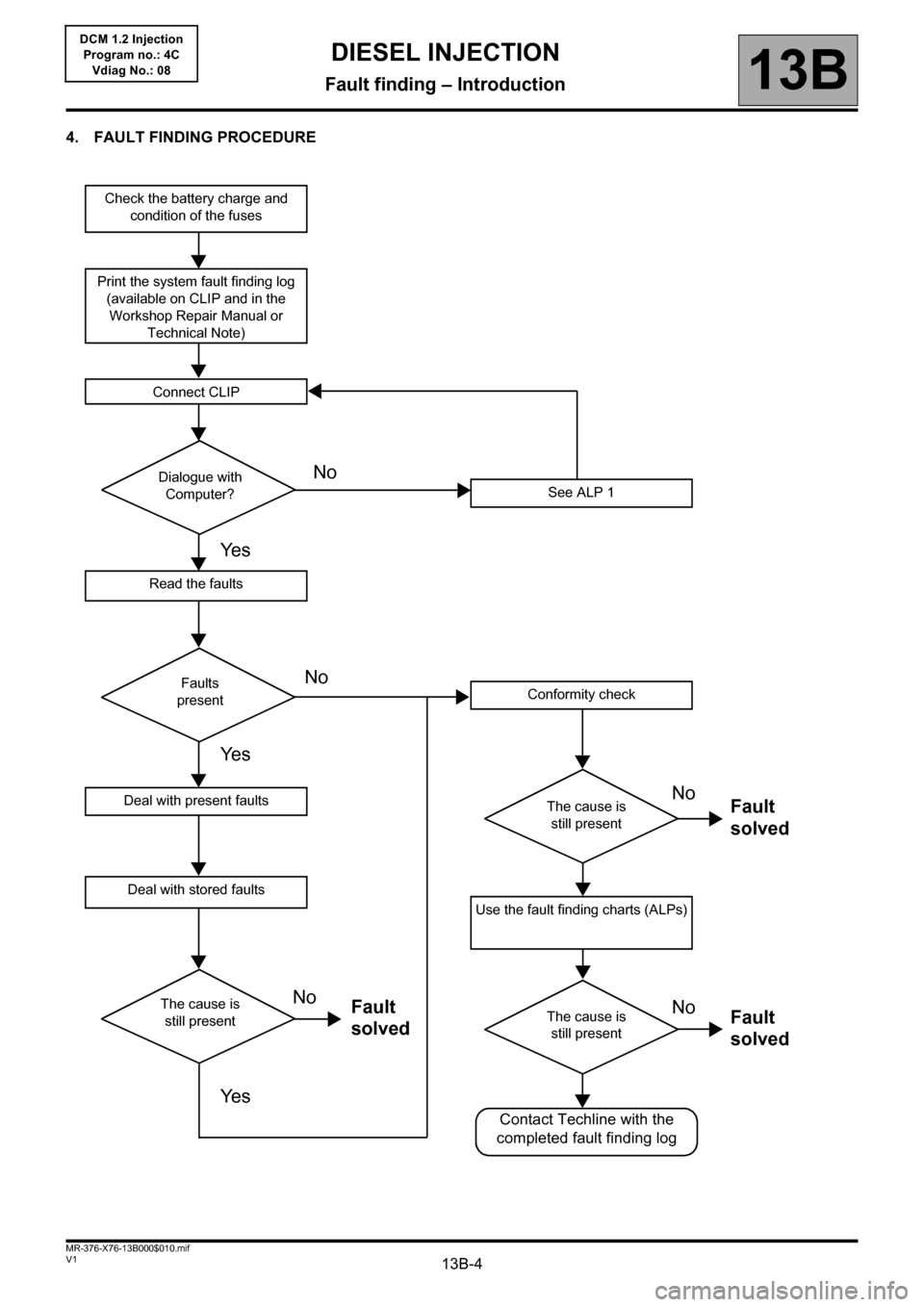
13B-4V1 MR-376-X76-13B000$010.mif
DIESEL INJECTION
Fault finding – Introduction13B
DCM 1.2 Injection
Program no.: 4C
Vdiag No.: 08
4. FAULT FINDING PROCEDURE
Check the battery charge and
condition of the fuses
Print the system fault finding log
(available on CLIP and in the
Workshop Repair Manual or
Technical Note)
Connect CLIP
See ALP 1
Read the faults
Deal with present faults
Deal with stored faults
Conformity check
Use the fault finding charts (ALPs)
Dialogue with
Computer?
Faults
present
The cause is
still present
The cause is
still presentThe cause is
still present
Contact Techline with the
completed fault finding log
No
NoNo
No No
Ye s
Ye s
Ye sFault
solvedFault
solved Fault
solved
Page 7 of 204
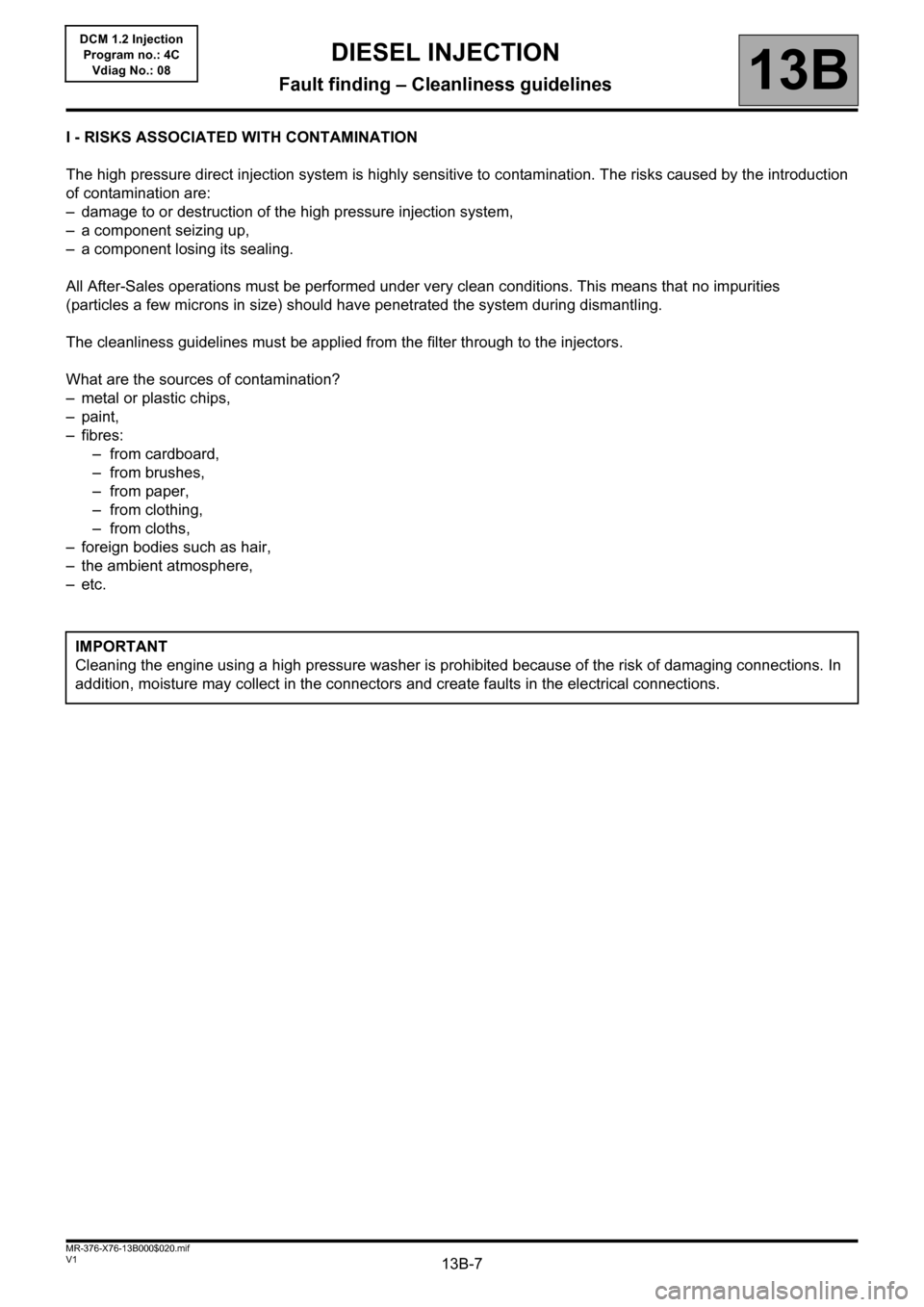
13B-7V1 MR-376-X76-13B000$020.mif
13B
DCM 1.2 Injection
Program no.: 4C
Vdiag No.: 08
I - RISKS ASSOCIATED WITH CONTAMINATION
The high pressure direct injection system is highly sensitive to contamination. The risks caused by the introduction
of contamination are:
– damage to or destruction of the high pressure injection system,
– a component seizing up,
– a component losing its sealing.
All After-Sales operations must be performed under very clean conditions. This means that no impurities
(particles a few microns in size) should have penetrated the system during dismantling.
The cleanliness guidelines must be applied from the filter through to the injectors.
What are the sources of contamination?
– metal or plastic chips,
– paint,
–fibres:
– from cardboard,
– from brushes,
– from paper,
– from clothing,
–from cloths,
– foreign bodies such as hair,
– the ambient atmosphere,
–etc.
IMPORTANT
Cleaning the engine using a high pressure washer is prohibited because of the risk of damaging connections. In
addition, moisture may collect in the connectors and create faults in the electrical connections.
DIESEL INJECTION
Fault finding – Cleanliness guidelines
Page 8 of 204

13B-8V1 MR-376-X76-13B000$020.mif
DIESEL INJECTION
Fault finding – Cleanliness guidelines13B
DCM 1.2 Injection
Program no.: 4C
Vdiag No.: 08
II - INSTRUCTIONS TO BE FOLLOWED BEFORE CARRYING OUT ANY WORK
Ensure that you have plugs for the unions to be opened (set of plugs available from the Parts Department). Plugs
are to be used only once. They must be discarded after use (once used they are soiled and cleaning is not sufficient
to make them reusable). Unused plugs must be thrown away.
Ensure that you have hermetically resealable plastic bags for storing removed parts. Parts stored in this way will be
less susceptible to the risk of contamination. The bags are to be used once only, and discarded after use.
Use lint-free cleaning cloths (cloth part reference 77 11 211 707). The use of ordinary cloth or paper is not permitted.
They are not lint-free and could contaminate the fuel circuit. A lint-free cloth should only be used once.
Use fresh cleaning agent for each operation (used cleaning agent is contaminated). Pour it into a clean receptacle.
For each operation, use a clean brush in good condition (the brush must not shed its bristles).
Use a brush and cleaning agent to clean the unions to be opened.
Blow compressed air over the cleaned parts (tools, workbench, the parts, unions and injection system zones).
Check that no bristles are left.
Wash your hands before and during the operation if necessary.
When wearing leather protective gloves cover them with latex gloves to prevent contamination.IMPORTANT
Before carrying out any work on the high pressure injection system, protect:
– the accessories belts,
– the electrical accessories, (starter, alternator, electric power-assisted steering pump),
– the flywheel surface, to prevent any diesel from running onto the clutch friction plate.
– timing chain
Page 12 of 204
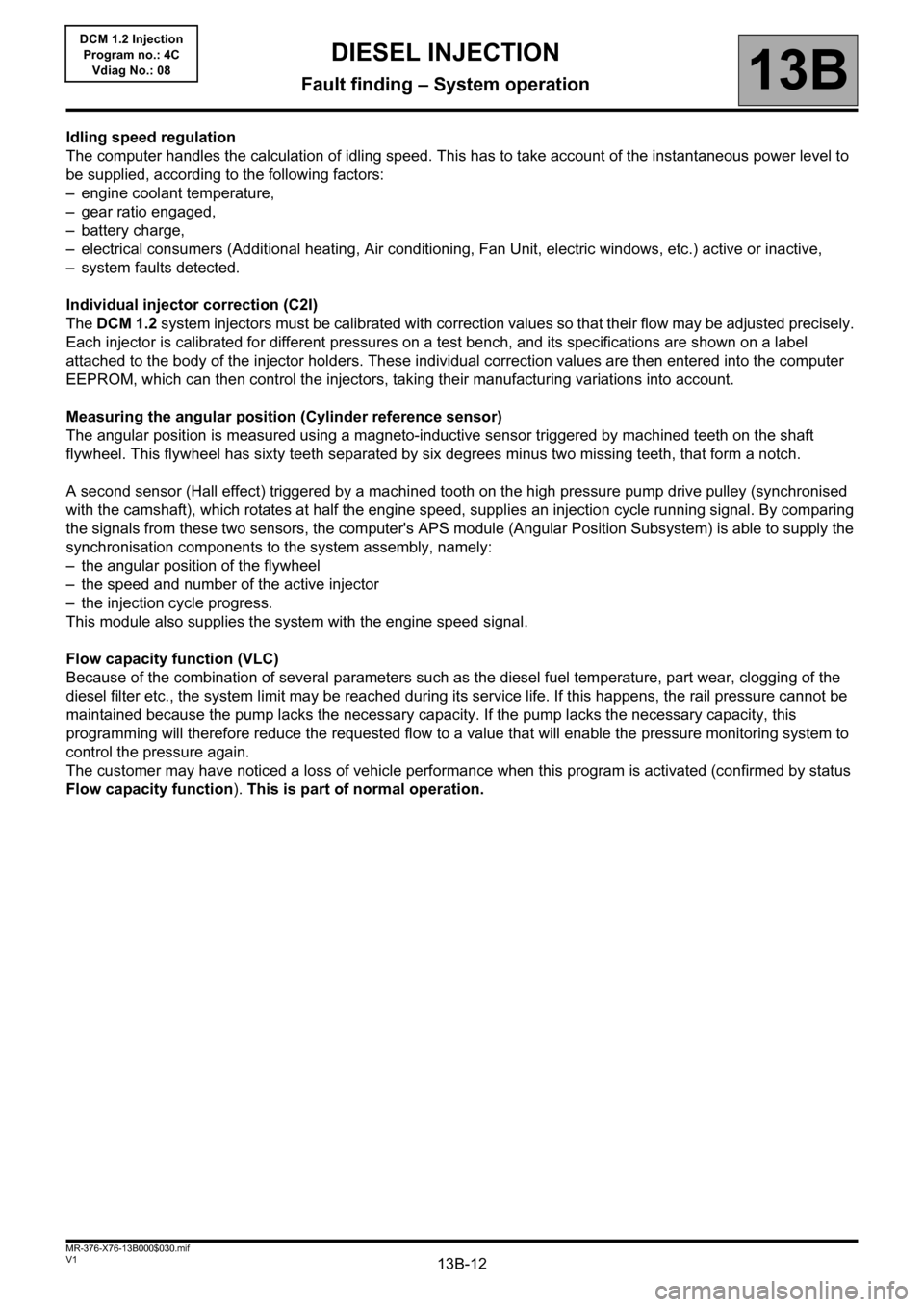
13B-12V1 MR-376-X76-13B000$030.mif
DIESEL INJECTION
Fault finding – System operation13B
DCM 1.2 Injection
Program no.: 4C
Vdiag No.: 08
Idling speed regulation
The computer handles the calculation of idling speed. This has to take account of the instantaneous power level to
be supplied, according to the following factors:
– engine coolant temperature,
– gear ratio engaged,
– battery charge,
– electrical consumers (Additional heating, Air conditioning, Fan Unit, electric windows, etc.) active or inactive,
– system faults detected.
Individual injector correction (C2I)
The DCM 1.2 system injectors must be calibrated with correction values so that their flow may be adjusted precisely.
Each injector is calibrated for different pressures on a test bench, and its specifications are shown on a label
attached to the body of the injector holders. These individual correction values are then entered into the computer
EEPROM, which can then control the injectors, taking their manufacturing variations into account.
Measuring the angular position (Cylinder reference sensor)
The angular position is measured using a magneto-inductive sensor triggered by machined teeth on the shaft
flywheel. This flywheel has sixty teeth separated by six degrees minus two missing teeth, that form a notch.
A second sensor (Hall effect) triggered by a machined tooth on the high pressure pump drive pulley (synchronised
with the camshaft), which rotates at half the engine speed, supplies an injection cycle running signal. By comparing
the signals from these two sensors, the computer's APS module (Angular Position Subsystem) is able to supply the
synchronisation components to the system assembly, namely:
– the angular position of the flywheel
– the speed and number of the active injector
– the injection cycle progress.
This module also supplies the system with the engine speed signal.
Flow capacity function (VLC)
Because of the combination of several parameters such as the diesel fuel temperature, part wear, clogging of the
diesel filter etc., the system limit may be reached during its service life. If this happens, the rail pressure cannot be
maintained because the pump lacks the necessary capacity. If the pump lacks the necessary capacity, this
programming will therefore reduce the requested flow to a value that will enable the pressure monitoring system to
control the pressure again.
The customer may have noticed a loss of vehicle performance when this program is activated (confirmed by status
Flow capacity function). This is part of normal operation.
Page 14 of 204
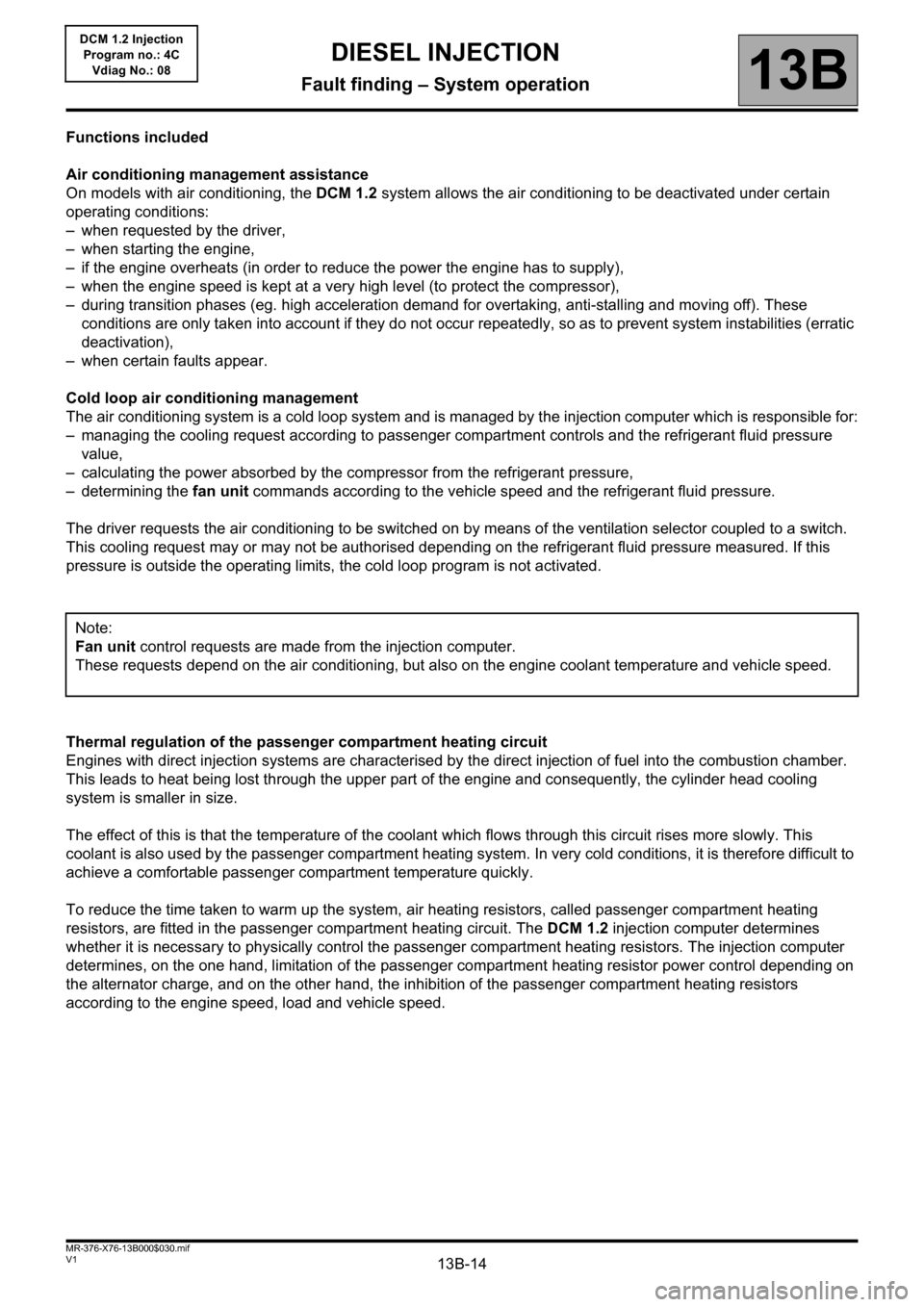
13B-14V1 MR-376-X76-13B000$030.mif
DIESEL INJECTION
Fault finding – System operation13B
DCM 1.2 Injection
Program no.: 4C
Vdiag No.: 08
Functions included
Air conditioning management assistance
On models with air conditioning, the DCM 1.2 system allows the air conditioning to be deactivated under certain
operating conditions:
– when requested by the driver,
– when starting the engine,
– if the engine overheats (in order to reduce the power the engine has to supply),
– when the engine speed is kept at a very high level (to protect the compressor),
– during transition phases (eg. high acceleration demand for overtaking, anti-stalling and moving off). These
conditions are only taken into account if they do not occur repeatedly, so as to prevent system instabilities (erratic
deactivation),
– when certain faults appear.
Cold loop air conditioning management
The air conditioning system is a cold loop system and is managed by the injection computer which is responsible for:
– managing the cooling request according to passenger compartment controls and the refrigerant fluid pressure
value,
– calculating the power absorbed by the compressor from the refrigerant pressure,
– determining the fan unit commands according to the vehicle speed and the refrigerant fluid pressure.
The driver requests the air conditioning to be switched on by means of the ventilation selector coupled to a switch.
This cooling request may or may not be authorised depending on the refrigerant fluid pressure measured. If this
pressure is outside the operating limits, the cold loop program is not activated.
Thermal regulation of the passenger compartment heating circuit
Engines with direct injection systems are characterised by the direct injection of fuel into the combustion chamber.
This leads to heat being lost through the upper part of the engine and consequently, the cylinder head cooling
system is smaller in size.
The effect of this is that the temperature of the coolant which flows through this circuit rises more slowly. This
coolant is also used by the passenger compartment heating system. In very cold conditions, it is therefore difficult to
achieve a comfortable passenger compartment temperature quickly.
To reduce the time taken to warm up the system, air heating resistors, called passenger compartment heating
resistors, are fitted in the passenger compartment heating circuit. The DCM 1.2 injection computer determines
whether it is necessary to physically control the passenger compartment heating resistors. The injection computer
determines, on the one hand, limitation of the passenger compartment heating resistor power control depending on
the alternator charge, and on the other hand, the inhibition of the passenger compartment heating resistors
according to the engine speed, load and vehicle speed.Note:
Fan unit control requests are made from the injection computer.
These requests depend on the air conditioning, but also on the engine coolant temperature and vehicle speed.
Page 17 of 204
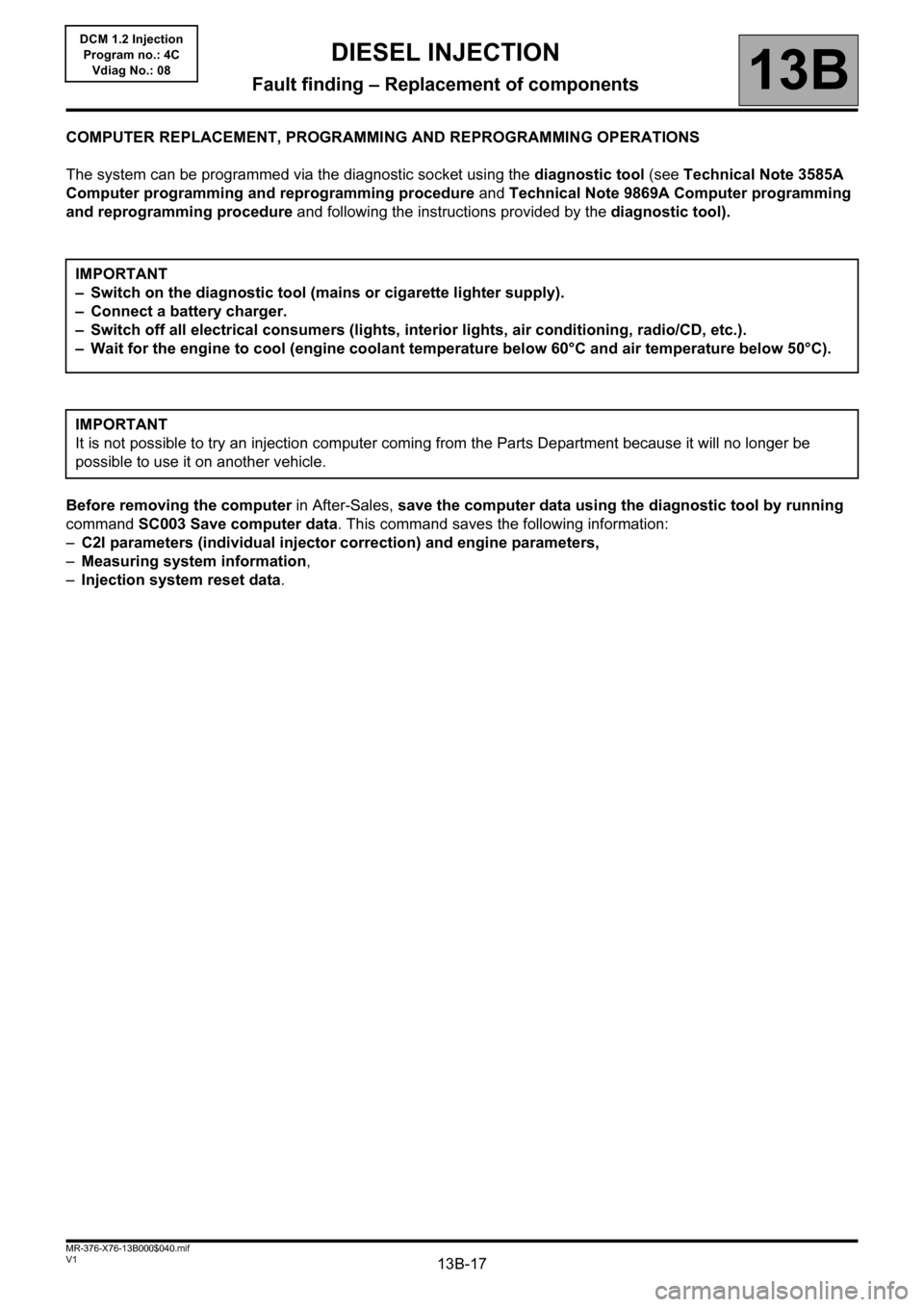
13B-17V1 MR-376-X76-13B000$040.mif
13B
DCM 1.2 Injection
Program no.: 4C
Vdiag No.: 08
COMPUTER REPLACEMENT, PROGRAMMING AND REPROGRAMMING OPERATIONS
The system can be programmed via the diagnostic socket using the diagnostic tool (see Technical Note 3585A
Computer programming and reprogramming procedure and Technical Note 9869A Computer programming
and reprogramming procedure and following the instructions provided by the diagnostic tool).
Before removing the computer in After-Sales, save the computer data using the diagnostic tool by running
command SC003 Save computer data. This command saves the following information:
–C2I parameters (individual injector correction) and engine parameters,
–Measuring system information,
–Injection system reset data. IMPORTANT
– Switch on the diagnostic tool (mains or cigarette lighter supply).
– Connect a battery charger.
– Switch off all electrical consumers (lights, interior lights, air conditioning, radio/CD, etc.).
– Wait for the engine to cool (engine coolant temperature below 60°C and air temperature below 50°C).
IMPORTANT
It is not possible to try an injection computer coming from the Parts Department because it will no longer be
possible to use it on another vehicle.
DIESEL INJECTION
Fault finding – Replacement of components
Page 24 of 204
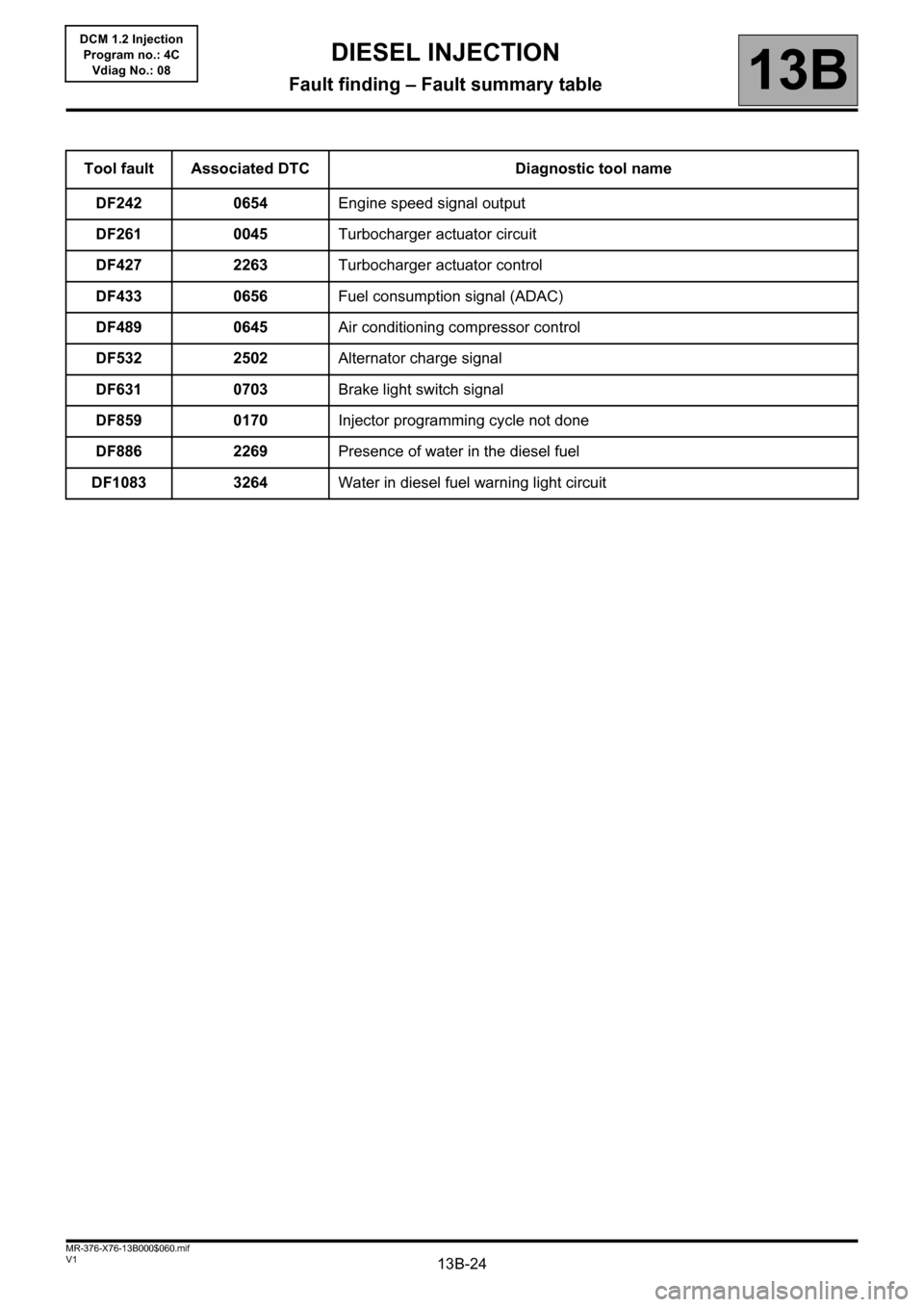
13B-24V1 MR-376-X76-13B000$060.mif
DIESEL INJECTION
Fault finding – Fault summary table13B
DCM 1.2 Injection
Program no.: 4C
Vdiag No.: 08
Tool fault Associated DTC Diagnostic tool name
DF242 0654Engine speed signal output
DF261 0045Turbocharger actuator circuit
DF427 2263Turbocharger actuator control
DF433 0656Fuel consumption signal (ADAC)
DF489 0645Air conditioning compressor control
DF532 2502Alternator charge signal
DF631 0703Brake light switch signal
DF859 0170Injector programming cycle not done
DF886 2269Presence of water in the diesel fuel
DF1083 3264Water in diesel fuel warning light circuit
Page 25 of 204
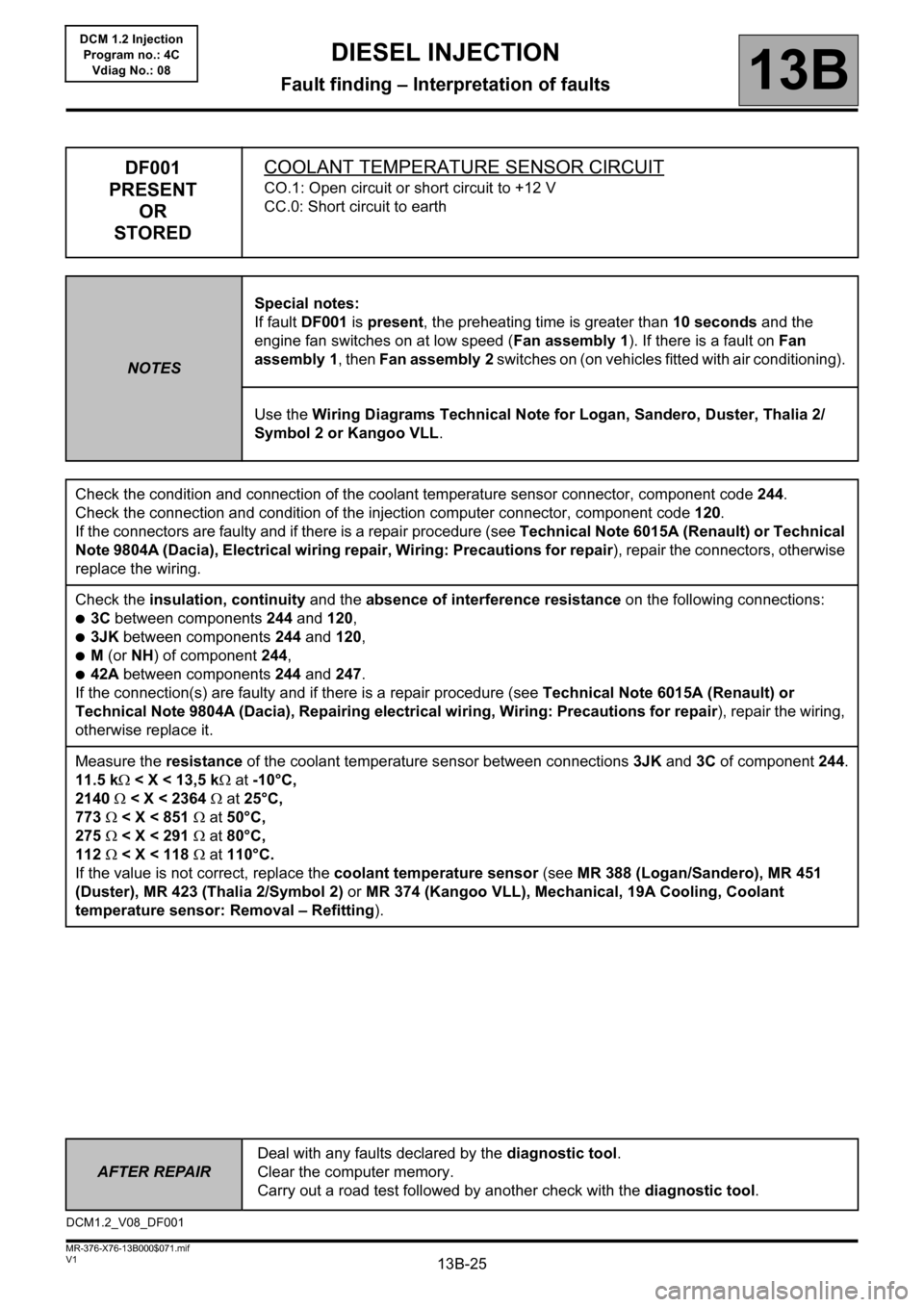
13B-25
AFTER REPAIRDeal with any faults declared by the diagnostic tool.
Clear the computer memory.
Carry out a road test followed by another check with the diagnostic tool.
V1 MR-376-X76-13B000$071.mif
13B
DCM 1.2 Injection
Program no.: 4C
Vdiag No.: 08
DF001
PRESENT
OR
STOREDCOOLANT TEMPERATURE SENSOR CIRCUIT
CO.1: Open circuit or short circuit to +12 V
CC.0: Short circuit to earth
NOTESSpecial notes:
If fault DF001 is present, the preheating time is greater than 10 seconds and the
engine fan switches on at low speed (Fan assembly 1). If there is a fault on Fan
assembly 1, then Fan assembly 2 switches on (on vehicles fitted with air conditioning).
Use the Wiring Diagrams Technical Note for Logan, Sandero, Duster, Thalia 2/
Symbol 2 or Kangoo VLL.
Check the condition and connection of the coolant temperature sensor connector, component code 244.
Check the connection and condition of the injection computer connector, component code 120.
If the connectors are faulty and if there is a repair procedure (see Technical Note 6015A (Renault) or Technical
Note 9804A (Dacia), Electrical wiring repair, Wiring: Precautions for repair), repair the connectors, otherwise
replace the wiring.
Check the insulation, continuity and the absence of interference resistance on the following connections:
●3C between components 244 and 120,
●3JK between components 244 and 120,
●M (or NH) of component 244,
●42A between components 244 and 247.
If the connection(s) are faulty and if there is a repair procedure (see Technical Note 6015A (Renault) or
Technical Note 9804A (Dacia), Repairing electrical wiring, Wiring: Precautions for repair), repair the wiring,
otherwise replace it.
Measure the resistance of the coolant temperature sensor between connections 3JK and 3C of component 244.
11.5 k < X < 13,5 k at -10°C,
2140 < X < 2364 at 25°C,
773 < X < 851 at 50°C,
275 < X < 291 at 80°C,
112 < X < 118 at 110°C.
If the value is not correct, replace the coolant temperature sensor (see MR 388 (Logan/Sandero), MR 451
(Duster), MR 423 (Thalia 2/Symbol 2) or MR 374 (Kangoo VLL), Mechanical, 19A Cooling, Coolant
temperature sensor: Removal – Refitting).
DCM1.2_V08_DF001
DIESEL INJECTION
Fault finding – Interpretation of faults
Page 26 of 204

13B-26
AFTER REPAIRDeal with any faults declared by the diagnostic tool.
Clear the computer memory.
Carry out a road test followed by another check with the diagnostic tool.
V1 MR-376-X76-13B000$071.mif
DIESEL INJECTION
Fault finding – Interpretation of faults13B
DCM 1.2 Injection
Program no.: 4C
Vdiag No.: 08
DF002
PRESENT
OR
STOREDAIR TEMPERATURE SENSOR CIRCUIT
CO.1: Open circuit or short circuit to +12 V
CC.0: Short circuit to earth
1.DEF: Inconsistency
NOTESPriority when dealing with a number of faults:
– DF113 Sensor supply voltage.
Special notes:
Use the Wiring Diagrams Technical Note for Logan, Sandero, Duster, Thalia 2/
Symbol 2 or Kangoo VLL.
Check the connection and condition of the connector of the air flow sensor, component code 799.
Check the condition of the injection computer connector, component code 120.
If the connectors are faulty and if there is a repair procedure (see Technical Note 6015A (Renault) or Technical
Note 9804A (Dacia), Electrical wiring repair, Wiring: Precautions for repair), repair the connectors, otherwise
replace the wiring.
Check for + 12 V after ignition on connection 3FB (or 3FBA) of the air flow sensor connector.
If the connection is faulty and if there is a repair procedure (see Technical Note 6015A (Renault) or Technical
Note 9804A (Dacia), Electrical wiring repair, Wiring: Precautions for repair), repair the wiring, otherwise
replace it.
Check the earth on connection NH of the air flow sensor.
If the connection is faulty and if there is a repair procedure (see Technical Note 6015A (Renault) or Technical
Note 9804A (Dacia), Electrical wiring repair, Wiring: Precautions for repair), repair the wiring, otherwise
replace it.
DCM1.2_V08_DF002